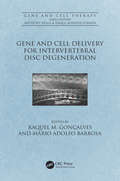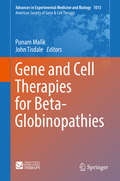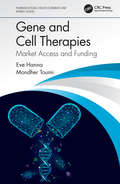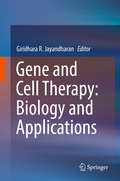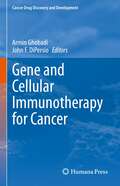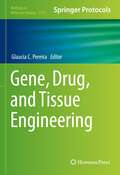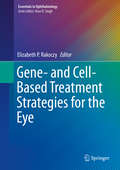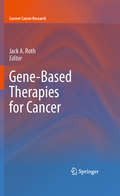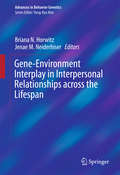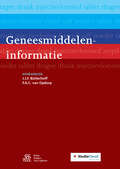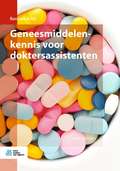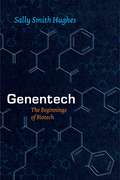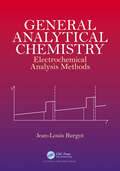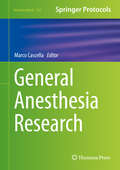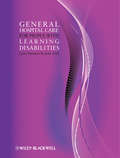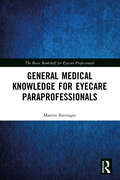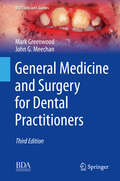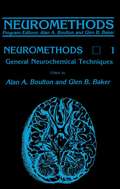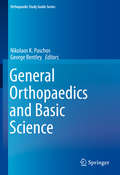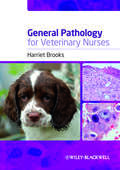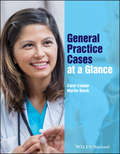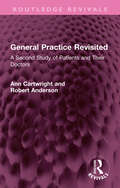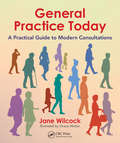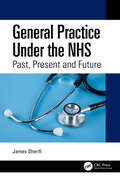- Table View
- List View
Gene and Cell Delivery for Intervertebral Disc Degeneration (Gene and Cell Therapy)
by Raquel Madeira Gonçalves Mario Adolfo BarbosaIntervertebral disc degeneration is one of the major causes of lower back pain for which the common therapeutic interventions are not efficient. A search for alternative therapies for lower back pain and intervertebral disc degeneration includes cell-based therapies. Unfortunately, intervertebral disc degeneration is avascular and thus a hostile environment for cell survival. Furthermore, cellular characterization in intervertebral disc degeneration, and particularly in the nucleus pulposus, is controversial, mainly due to lack of specific markers and species variability. This book adds to the knowledge on cellular and molecular therapies for intervertebral disc degeneration and associated lower back pain. <P><P>Key Selling Features: <li>Describes the ontogeny and phenotype of intervertebral disc cells <li>Reviews the role that inflammation plays in disco-genic pain <li>Highlights the types of cells that might be used as sources for treating degenerating intervertebral discs <li>Summarizes current alternative therapies <li>Explores methods for cell delivery into degenerated intervertebral discs
Gene and Cell Therapies for Beta-Globinopathies
by Punam Malik John TisdaleHemoglobin defects, specifically sickle cell disease & thalassemia, combined, constitute the most common monogenic disorders in the world. In fact, nearly 2% of the world's population carries a globin gene mutation. The transfer of the corrective globin gene through the HSC compartment by allogeneic HSC transplantation (HSCT) has already proven curative in both SCD and thalassemia patients, and provides the proof of concept that genetic manipulation of the defective organ might be equally therapeutic. However, procedural toxicities and the requirement of an HLA-matched sibling donor limit this approach to a fraction of affected individuals. The editors review the progress & the state of the field in HSCT for hemoglobinopathies & shed light on the major changes expected in the next decade. Although allogeneic HSCT is a curative option, it is limited by the availability of matched donors, which are often available only to 15-20% of patients. An alternative to allogeneic HS CT is genetic correction of autologous HSCs, to overcome donor availability & immune side effects. This Book reviews the progress made on additive gene therapy approaches & the current state of the field. Finally, targeted genetic correction is emerging as a novel therapeutic strategy in the hemoglobinopathies. Although ideal, the inefficiency of targeted correction was rate limiting for translation of this technology to the clinic. With advancements in zinc finger nucleases and TALE endonuclease mediated targeted correction, correction frequencies in hematopoietic stem cells is now reaching levels that may become clinically relevant. Furthermore, the ability to generate autologous embryonic stem cell like cells from primary somatic cells (skin fibroblasts or hematopoietic cells) of the affected individual has allowed for the potential application of genetic correction strategies. This Book reviews upcoming genetic strategies to reactivate fetal hemoglobin production and research advances.
Gene and Cell Therapies: Market Access and Funding (Pharmaceuticals, Health Economics and Market Access)
by Mondher Toumi Eve HannaThe major advances in the field of biotechnology and molecular biology in the twenty-first century have led to a better understanding of the pathophysiology of diseases. A new generation of biopharmaceuticals has emerged, including a wide and heterogeneous range of innovative cell and gene therapies. These therapies aim to prevent or treat chronic and serious life-threatening diseases, previously considered incurable. This book describes the evolution and adaptation of the regulatory environment to assess these therapies in contrast with the resistance of health technology assessment (HTA) agencies and payers to acknowledge the specificity of cell and gene therapies and the need to adapt existing decision-making frameworks. This book provides insights on the learnings from the experience of current cell and gene therapies (regulatory approval, HTA, and market access), in addition to future trends to enhance patient access to these therapies. Key Features: Describes the potential change of treatment paradigm and the specificity of cell and gene therapies, including the gradual move from repeated treatment administration to one-time single administration with the potential to be definite cure Highlights the challenges at the HTA level Discusses the affordability of future cell and gene therapies and the possible challenges for health insurance systems Provides potential solutions to address these challenges and ensure patient access to innovation while maintaining the sustainability of healthcare systems
Gene and Cell Therapy: Biology and Applications
by Giridhara R. JayandharanRecent advances in stem cell biology, nanotechnology and gene therapy have opened new avenues for therapeutics. The availability of molecular therapeutics that rely on the delivery of DNA, RNA or proteins, harnessing enhanced delivery with nanoparticles, and the regenerative potential of stem cells (adult, embryonic or induced pluripotent stem cells) has had a tremendous impact on translational medicine. The chapters in this book cover a range of strategies for molecular and cellular therapies for human disease, their advantages, and central challenges to their widespread application. Potential solutions to these issues are also discussed in detail. Further, the book addresses numerous advances in the field of molecular therapeutics that will be of interest to the general scientific community. Lastly, the book provides specific examples of disease conditions for which these strategies have been transferred to the clinic. As such, it will be extremely useful for all students, researchers and clinicians working in the field of translational medicine and molecular therapeutics.
Gene and Cellular Immunotherapy for Cancer (Cancer Drug Discovery and Development)
by Armin Ghobadi John F. DiPersioClinical and preclinical exploration of gene and cellular immunotherapy have seen rapid growth and interest with the development and approval of five Chimeric Antigen Receptor T-cell (CAR-T) products for lymphoma and myeloma and one Bispecific T-Cell Engager (BiTE) for acute lymphoblastic leukemia (ALL). These advances have dramatically improved the management of patients with relapsed refractory lymphoma, myeloma and leukemia. Gene and Cellular Immunotherapy for Cancer offers readers a comprehensive review of current cellular and gene-based immunotherapies. Divided into eighteen cohesive chapters, this book provides an in-depth and detailed look into cellular-based immunotherapies including CAR-T, TCR-T, TIL, Viral CTLs, NK cells in addition to T/NK cell engagers, focusing on their historical perspectives, biology, development and manufacturing, toxicities and more. Edited by two leading experts on gene and cellular immunotherapy, the book will feature chapters written by a diverse collection of recognized and up-and-coming experts and researchers in the field, providing oncologists, immunologists, researchers and clinical and basic science trainees with a bench to bedside view of the latest developments in the field.
Gene, Drug, and Tissue Engineering (Methods in Molecular Biology #2575)
by Glaucia C. PereiraThis book combines discursive chapters that present the latest progress in molecular biology, drug discovery, organ-tissue engineering, and related fields, with a number of descriptive chapters on methods, protocols, and case studies. Structured into four parts, this volume walks the reader through the latest in cellular biology, with discussions on novel medicinal plant metabolites, nanotechnology in precision medicine, nucleic acid-based therapeutics and vaccines, genetic engineering, computational aid, bioinformatics, synthetic organs for transplantation, and organ-tissue engineering. Written for the highly successful Methods in Molecular Biology series, chapters include the kind of detail and expert implementation advice that ensures quality results in the lab. Authoritative and informative, Gene, Drug, and Tissue Engineering serves as an ideal guide for undergraduate students, postgraduate researchers, and senior researchers working in biomedicine and its underlying technologies, stimulating both computational and experimental development and fostering the exchange of new ideas.
Gene- and Cell-Based Treatment Strategies for the Eye
by Elizabeth P. RakoczyIn this book, leading experts provide detailed descriptions of the exciting treatments that are expected to become part of the ophthalmologist's arsenal within the next 10-20 years. The treatments discussed relate to a wide variety of conditions, including macular degeneration, Leber's congenital amaurosis, retinitis pigmentosa, choroideremia, and retinoschisis. The authors explain clearly how different gene and cell therapies work and provide first-hand accounts of the difficulties that they have faced in bringing these technologies to clinical trial, such as issues relating to funding and ownership. Results achieved to date are presented, and the further steps required before the treatment in question can become a routine option are considered. Gene- and Cell-Based Treatment Strategies for the Eye is unique in showing the organic development of cutting-edge science into potential treatments for eye disease without compromising on accurate reporting of scientific facts. It will persuade the average practitioner or researcher - whether ophthalmologist, health worker, or scientist - that change is indeed coming and is not just a hollow promise of the tabloid media.
Gene-Based Therapies for Cancer
by Jack A. RothCancer gene therapy is a novel therapy that targets the underlying genetic defects in the cancer cell. Progress in this field has been rapid and gene therapy promises to further extend personalized cancer treatment. In this volume leading experts have contributed their experience in developing gene therapies for a variety of cancers. Translational gene therapy approaches are emphasized. Chapters include discussions of specific gene delivery technologies as well as their application to various cancers with extensive discussions of ongoing clinical trials. This information should be useful to both students, fellows, and experienced scientists with an interest in this rapidly developing area.
Gene-Environment Interactions in Developmental Psychopathology
by Michael Rutter Kenneth DodgeBringing together foremost experts, this book reviews groundbreaking gene-environment research and explores implications for clinical practice, prevention, and public policy. Presented is cutting-edge work on the interplay of genetic factors and childhood experiences in the development of mental disorders such as depression, conduct disorder, and schizophrenia. Essential topics include what scientists currently know about "susceptibility genes"; the mechanisms by which maltreatment and other stressors interact with biological susceptibilities across development; and factors that make certain children more resilient than others. Future directions for personalizing treatment and prevention efforts, thus making them more effective, are discussed.
Gene-Environment Interplay in Interpersonal Relationships across the Lifespan
by Briana N. Horwitz Jenae M. NeiderhiserIntriguing new findings on how genes and environments work together through different stages of life take the spotlight in this significant collection. Studies from infancy to late adulthood show both forces as shaping individuals' relationships within family and non-family contexts, and examine how these relationships, in turn, continue to shape the individual. Transitional periods, in which individuals become more autonomous and relationships and personal identities become more complicated, receive special emphasis. In addition, chapters shed light on the extent to which the quantity and quality of genetic and environmental influence may shift across and even within life stages. Included in the coverage: Gene-environment interplay in parenting young children. The sibling relationship as a source of shared environment. Gene-environment transactions in childhood and adolescent problematic peer relationships. Toward a developmentally sensitive and genetically informed perspective on popularity. Spouse, parent, and co-worker: roles and relationships in adulthood. The family system as a unit of clinical care: the role of genetic systems. Behavioral geneticists, clinical psychologists, and family therapists will find in Gene-Environment Interplay in Interpersonal Relationships across the Lifespan a window into current thinking on the subject, new perspectives for understanding clients and cases, and ideas for further study.
Geneesmiddeleninformatie
by M. L. Bouvy W. S. Dessing E.M.W. Garde T. Gerbranda A. M. Harmsze P.H.M. Kuy A. Nooij K.A. Simons-Sanders P. Stolk B.C.M.J. Takx-Köhlen T. ZwaanJ.J.F. Bütterhoff F.A.C. OpdorpGeneesmiddeleninformatie is een handboek en naslagwerk bestemd voor verpleegkundigen, apothekersassistenten, praktijkondersteuners en anderen die in hun dagelijkse werkzaamheden met geneesmiddelen in aanraking komen. Een goede kennis van geneesmiddelen is voor al deze groepen onontbeerlijk.De afgelopen jaren is de behandeling met geneesmiddelen complexer geworden. De hulp van verpleegkundigen wordt steeds vaker ingeroepen bij de toenemende thuisbehandeling, en hbo-geschoolde farmakundigen en farmaceutisch consulenten hebben hun entree gemaakt. Ook het voorschrijven van geneesmiddelen door nursepractitioners is bijna een feit.Deze achtste druk van Geneesmiddeleninformatie is inhoudelijk grondig herzien en aangepast aan de eisen van deze tijd. Nieuwe geneesmiddelen zijn toegevoegd, oude vervangen of geschrapt. In verband met de introductie van generiek voorschrijven in de ziekenhuizen is in de tekst gekozen voor de generieke naam van geneesmiddelen. Wel worden in tabellen de merknamen genoemd. In deze nieuwe editie is de indeling overzichtelijker gemaakt. De hoofdstukken die bij elkaar horen op basis van hun werking, zijn geclusterd in blokken.
Geneesmiddelenkennis voor doktersassistenten (Basiswerk AG)
by J. van AmerongenDit boek geeft doktersassistenten en praktijkondersteuners (in opleiding) gedegen kennis over geneesmiddelen en vertaalt die kennis naar de praktijk. Zo kun je dankzij de informatie in dit boek het spoedeisende karakter van een hulpvraag beter bepalen als een patiënt ook medicijnen gebruikt. Bovendien ben je in staat om patiënten voor te lichten en te adviseren over de werking en toepassing van geneesmiddelen.In deze zesde druk van Geneesmiddelenkennis voor doktersassistenten zijn de verschillende geneesmiddelengroepen en onderliggende medicatie geactualiseerd. Ook zijn er paragrafen toegevoegd over onder meer geneesmiddelen in het verkeer, bij zwangerschap en bij borstvoeding. De verschillende onderdelen over auto-immuunziekten zijn in deze druk samengevoegd waarbij ook aandacht gegeven is aan de stormachtige ontwikkeling van de biologicals en biosimilars.Het boek geeft eerst een algemene inleiding over geneesmiddelen en bespreekt dan de meest gebruikte medicijnen aan de hand van orgaanstelsels.Geneesmiddelenkennis voor doktersassistenten is bij uitstek geschikt voor doktersassistenten, praktijkondersteuners en degenen die daarvoor worden opgeleid.Jan van Amerongen is als arts (niet-praktiserend) verbonden aan het Alfa-college te Hoogeveen. Daarnaast is hij actief bij de nascholing van doktersassistenten in Noord-Nederland.
Genentech: The Beginnings of Biotech (Synthesis Ser.)
by Sally Smith HughesIn the fall of 1980, Genentech, Inc., a little-known California genetic engineering company, became the overnight darling of Wall Street, raising over $38 million in its initial public stock offering. Lacking marketed products or substantial profit, the firm nonetheless saw its share price escalate from $35 to $89 in the first few minutes of trading, at that point the largest gain in stock market history. Coming at a time of economic recession and declining technological competitiveness in the United States, the event provoked banner headlines and ignited a period of speculative frenzy over biotechnology as a revolutionary means for creating new and better kinds of pharmaceuticals, untold profit, and a possible solution to national economic malaise. Drawing from an unparalleled collection of interviews with early biotech players, Sally Smith Hughes offers the first book-length history of this pioneering company, depicting Genentech’s improbable creation, precarious youth, and ascent to immense prosperity. Hughes provides intimate portraits of the people significant to Genentech’s science and business, including cofounders Herbert Boyer and Robert Swanson, and in doing so sheds new light on how personality affects the growth of science. By placing Genentech’s founders, followers, opponents, victims, and beneficiaries in context, Hughes also demonstrates how science interacts with commercial and legal interests and university research, and with government regulation, venture capital, and commercial profits. Integrating the scientific, the corporate, the contextual, and the personal, Genentech tells the story of biotechnology as it is not often told, as a risky and improbable entrepreneurial venture that had to overcome a number of powerful forces working against it.
General Analytical Chemistry: Electrochemical Analysis Methods
by Jean-Louis BurgotThis book is devoted to the quantitative electrochemical methods of analysis in solution. A theoretical knowledge of each method is discussed. The methods are illustrated with several examples covering a wide range of types of analysis. The book is divided in three parts. The first one is introductory. It recalls some definitions and some basic concepts of electrochemistry. The second part describes the methods themselves. Are studied voltametric methods, amperometry, potentiometry, conductometry, the electrogravimetry and coulometry. Some chapters are also dedicated to the chemical and electrochemical sensors. The third part consists in a supplementary theoretical knowledge of each method.
General Anesthesia Research (Neuromethods #150)
by Marco CascellaThis book explores several aspects of the research in the field of general anesthesia, including mechanisms of action of inhaled and intravenous hypnotic agents; the anesthetics-induced neurotoxicity in children and elderly; features and physiopathology of postoperative cognitive side effects; and findings from preclinical research focused on the recognition of potential links between anesthetics and cancer cell biology. Furthermore, chapters in this book cover technical topics such as preoperative monitoring of autonomic nervous activity; EEG based monitoring of general anesthesia; monitoring cerebral oximetry by near infrared spectroscopy; pharmacological issues of anesthesia interest; and optimization of perioperative course through the latest techniques such as the opioid-free anesthesia. Finally, this book offers a comprehensive and up-to-date discussion on the phenomenon of general anesthesia awareness and its potential psychological sequelae. In Neuromethods series style, chapters include the kind of detail and key advice from the specialists needed to get successful results in your laboratory. Cutting-edge and comprehensive, General Anesthesia Research is a valuable resource for novice and expert anesthesiologists who want to learn more about the important advances made in this developing field.
General Hospital Care for People with Learning Disabilities
by Julie Clift Lynn HannonGeneral Hospital Care for People with Learning Disabilities is a comprehensive resource for those health professionals in a general hospital setting who may come into contact with people with learning disabilities. The book explores the nature of learning disabilities and highlights specific healthcare needs. It takes the reader through all the key factors in the healthcare process, through pre-admission assessment, care planning, intervention and treatment, and liaison and discharge planning, while highlighting key healthcare needs at each stage. The Department of Health, the National Health Service Executive and Mencap have all reported that people with learning disabilities have increased health needs compared to the general population, yet these needs are often poorly met and people experience difficulties in accessing appropriate services. This is a timely and accessible resource for healthcare professionals in need of a general introduction to caring for people with a learning disability. Relevant to the care of both children and adults with a learning disability Use of case studies to illustrate examples of situations explored in the main text Focuses on key areas of communication, understanding behavior and the often difficult area of consent
General Medical Knowledge for Eyecare Paraprofessionals (The Basic Bookshelf for Eyecare Professionals)
by Marvin BittingerThe Basic Bookshelf for Eyecare Professionals is a series that provides fundamental and advanced material with a clinical approach to clinicians and students. A special effort was made to cover information needed for the certification exams in ophthalmic and optometric assisting, low vision, surgical assisting, opticianry, and contact lens examiners.General Medical Knowledge is designed for those needing to learn or brush up on the anatomy and physiology of the human body. This book emphasizes the fact that the eye is part of the body as a whole and presents the basic concepts of anatomy and physiology as well as an overview of common diseases. The first section begins with cells and tissues, then discusses the various organ systems including cardiovascular, respiratory, endocrine, and nervous. The second section covers systemic diseases and disorders including connective tissue disease, age related disorders, and neoplastic disorders, with special emphasis on how each of these can affect the eye. This text will provide a solid foundation of general medical knowledge for those working as eyecare professionals.
General Medicine and Surgery for Dental Practitioners (BDJ Clinician's Guides)
by Mark Greenwood John G. MeechanAimed at the practising clinician, this book, now in its third edition, provides a welcome detailed overview of the medical and surgical conditions that affect patients seen in everyday dental practice. With patients surviving longer due to medical advances, dentists are increasingly faced with complex conditions and possibly some that they have not previously encountered. Here, treatment advice, drug interactions, and the impact of general medical and surgical conditions on treatment planning in the dental context are all covered with a comprehensive but practical approach. In addition to chapters on the implications for dental practice of disorders of each of the different body systems and immunological and infectious diseases, important aspects in particular patient groups, including cancer patients, the elderly, and the paediatric population, are identified. Overall, this book provides dentists with a practical, logical, and convenient guide of great value, helping to update knowledge and foster improved patient care.
General Orthopaedics and Basic Science (Orthopaedic Study Guide Series)
by George Bentley Nikolaos K. PaschosThis volume of the Orthopaedic Study Guide Series provides the foundation of general orthopedic and basic science. Chapters of this book cohere around three aspects of the musculoskeletal system, anatomy, physiology, and pathology. Next to basic principles, case reports underline key information relating to disorders, diagnosis, and treatment options. Written by leading experts, this volume is a concise guide designed as quick reference, thereby it presents a useful resource for orthopedic residents and fellows.
General Pathology for Veterinary Nurses
by Harriet BrooksA good understanding of pathology will turn a competent veterinary nurse into an outstanding one. Harriet Brooks. This is one of the first books on general pathology designed specifically for veterinary nurses and veterinary nursing students. Pathology underpins all you do as a veterinary nurse. Knowledge of the general pathological processes will give you a deeper understanding of every aspect of an animal’s health. Building on your prior knowledge of anatomy, physiology and biochemistry, the book explains the pathological changes that occur in sick animals. It describes the various disease processes and shows you how to relate them to clinical presentation, diagnosis and prognosis, and treatment rationales. This book will give you the knowledge and confidence to develop your role within the veterinary team. Designed as a concise, easy to read textbook, it includes: Detailed illustrations to explain the science behind the pathological processes Summary boxes of key information to aid revision A ‘test yourself’ section at the end of each chapter
General Practice Cases at a Glance
by Carol Cooper Martin BlockGeneral Practice Cases at a Glance is a workbook of clinical scenarios, ideal for those working in general practice, on their GP rotations, or looking to improve their history-taking, diagnostic and management planning skills. Written by practising teaching GPs, it provides an accessible overview of the richness and complexity of general practice.With 50 engaging consultations, covering all age ranges and a broad spread of clinical areas, each symptom-based chapter begins with the clinical presentation of a patient, before going on to uncover the full history and examination. As you work through each true-to-life case, there are red flag symptoms, useful charts and tables, and further resources to deepen your knowledge. General Practice Cases at a Glance:* Is suitable for clinical students, Foundation doctors, and those preparing for the MRCGP's CSA* Includes 50 case scenarios from across the medical spectrum, from mental health and paediatrics to musculoskeletal and ENT medicine* Is comprehensively illustrated * Features current clinical guidelines, and charts and tables to accompany each case* Is the companion volume to General Practice at a Glance, ISBN 9780470655511, (Awarded First Prize in the Primary health care category at the 2013 BMA Medical Book Awards) but is also a stand-alone resource
General Practice Revisited: A Second Study of Patients and Their Doctors (Routledge Revivals)
by Robert Anderson Ann Cartwright‘This study of general practice and the attitudes of patients and general practitioners to it is the most significant book yet written about the NHS.’ This was how the reviewer in the ‘British Medical Journal’ reviewed Ann Cartwright’s earlier book Patients and their Doctors. In General Practice Revisited, originally published in 1981, Ann Cartwright and Robert Anderson compare the experiences and views described in the first study, carried out in 1964, with those revealed by a second survey in 1977.In the intervening period there were a great many changes in the organization of general practice. For example appointment systems and nurses working in the surgery became the rule rather than the exception, and the number of doctors working in health centres or using deputizing services rose dramatically. This study shows how the basic patient-doctor relationship has been affected by these changes. A fundamental feature of the survey is the demonstration that the attitudes and practices of patients and doctors are linked, and that it is possible to relate the experiences and degree of satisfaction of patients to the doctor’s age, sex, size of practice, equipment, ancillary help, and indeed to the doctor’s views and habits.By bringing the picture of general practice up-to-date Ann Cartwright and Robert Anderson provided the basic data for any discussion of primary health care in this country at the time.
General Practice Today: A Practical Guide to Modern Consultations
by Jane WilcockGeneral Practice Today explores the GP consultation in the context of external 'stressors' and 'helpers' that doctors use to make best clinical decisions. Over the last 30 years there has been a move towards mandatory training on legal aspects, risk scores and guidance. Additionally, with widespread access to IT there has been a huge growth in the information doctors need to know and manage. Yet today’s GP has never been more time-poor or under so much pressure. All these outside considerations can seem challenging and remote for the doctor sat with their patient; yet in today’s reality they have never been more important. This book offers insight into the practical impact and importance of these external factors. It offers advice on everything from law, technology and time management to mental health issues, ethics, religion and culture, exploring how to determine which issues are relevant to each individual consultation. Packing each chapter with realistic examples, author Jane Wilcock draws on her own extensive experience to help GPs make considered, contextual decisions that enhance the health and well-being of their patients. This book is essential reading for any General Practitioner, allied health care practitioner or trainee preparing to practice in our complex modern world.
General Practice Under the NHS: Past, Present and Future
by James SherifiThis accessible text covers the entirety of General Practice and the General Practitioner, from student to retirement and from the beginning of the NHS to the present day. It provides a comprehensive historical overview representing both academic and front-line perspectives, describing what has changed, beneficial or otherwise, as the specialty has evolved. The details within each chapter represent the views of the average working British GP and illustrate how the changes over the decades have impacted patient care and its delivery. The perspective often differs from that which prevails in many academic tomes on the subject. The topics covered, from the primary care team, changes to out-of-hours provision, the impact of IT, training, and regulation, to the future of General Practice, will be essential reading for all doctors considering a career in the specialty and will also be of interest to GP vocational training scheme course organisers and trainers, overseas medical educators and healthcare policy makers, social and medical historians, and the general public.
